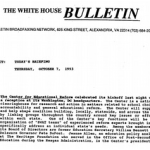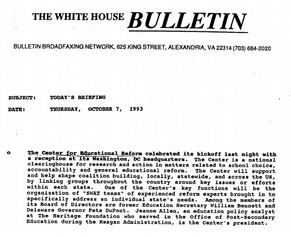
My Friday morning journey to Capital City Public Charter School (PCS) was filled with transit catastrophes and rainy weather, but when I entered the school, all negativity melted away when I was met with a warm atmosphere and welcoming faculty. The school building itself is massive, since all grades learn in the same building, but a student named Avery was sweet enough to walk me to my starting point of the tour. Capital City uses a hands-on learning approach, which is evident by the project-based learning model implemented in all classrooms. In fact, expeditionary learning is quite literally built into the framework of the school because in 2011, the seventh and eighth grade students created and published goal books for environmentally friendly buildings and presented their findings to the school board. Students really do become advocates, an initiative that is important to the social curriculum of character development that Capital City PCS values.
 Throughout my tour, I saw the hands-on learning approach put into action with projects starting with preschoolers learning about ants, up to high school students presenting research on healthy lifestyles. Research, fieldwork, and findings were all posted on the walls of the school and students were participating in curriculum based on that topic. In a fifth grade classroom I sat in on, they were discussing their unit about the Constitution and Bill of Rights and they were highlighting important points and making comprehensive explanations for younger grades. They also reflected on their “Day Without Rights” experience and spoke about how laws were important in order to cultivate a safe and free society. At Capital City, in order for students to move onto middle school and later, graduation, they must present a packet of lessons they have learned to a board made up of community members. In this presentation, they address things they did well on in research, things they could have done better, and fascinating things they found out about themselves and their peers along the way. This type of reflection is unique and so important in an academic setting, and Capital City works hard to make that a major part of the curriculum.
Throughout my tour, I saw the hands-on learning approach put into action with projects starting with preschoolers learning about ants, up to high school students presenting research on healthy lifestyles. Research, fieldwork, and findings were all posted on the walls of the school and students were participating in curriculum based on that topic. In a fifth grade classroom I sat in on, they were discussing their unit about the Constitution and Bill of Rights and they were highlighting important points and making comprehensive explanations for younger grades. They also reflected on their “Day Without Rights” experience and spoke about how laws were important in order to cultivate a safe and free society. At Capital City, in order for students to move onto middle school and later, graduation, they must present a packet of lessons they have learned to a board made up of community members. In this presentation, they address things they did well on in research, things they could have done better, and fascinating things they found out about themselves and their peers along the way. This type of reflection is unique and so important in an academic setting, and Capital City works hard to make that a major part of the curriculum.
Capital City PCS has the highest percentage of students currently enrolled in college from the class of 2014 of any DC high school. This parent-founded school strives to challenge every single student and does so by making every student an advocate. The research skills that the students learn through long-term projects shape their character and prepare them for the rigor of higher education. The school recognizes that education is not one-size-fits-all, and instead works to accommodate and challenge the students on their individual levels. In a curriculum that focuses on building independence and character, the students really do act as workers with teachers as coaches.
Brett Swanson, CER Intern












Closing the Semester’s Chapter
My internship here at The Center for Education Reform (CER) is drawing to a close and although I have spent an entire semester here, I am finding it hard to piece together words that accurately describe my experience. I met Outreach Coordinator, Tyler, at a nonprofit networking event, and immediately was hooked on CER and everything the organization stood for. On my first day, I was blown away by how much was going on at all times around the office. Press releases were being written, phone interviews were taking place, and all of the sudden I was heading out the door to attend a panel event. Amongst all of the hard work and deadlines, the thing that immediately separated CER from other offices was the heart that the staff puts into the work.
One of the most rewarding takeaways of this experience is seeing how many great people are behind education reform and knowing that I, in some way, helped. Updating data, researching topics, going to events, visiting charter schools; all of these day-to-day tasks I accomplished all went toward a greater goal. I loved that this wasn’t an internship where people were just clocking in and out. Instead, it was an environment of individuals who actually care about making education better. Attending events opened my eyes to the power of conversation and human interaction. I learned so much about other areas of education reform just by attending events and striking up conversation about CER and other organizations with those around me. It was amazing to be able to attend panel discussions, which covered education research and data, as well as First Fridays, where I could experience a more hands-on approach by visiting charter school classrooms. The mix of traveling to events and researching from a computer gave me an authentic behind-the-scenes experience with policy reform.
As an intern at CER, I was also able to write for the Media Bullpen. Analyzing and summarizing articles for the Media Bullpen has changed the way I interpret information and has allowed me to inform other people of news in just a few quick, analytical sentences. Writing those responses has made me more aware of current affairs, both nationally and locally, and has equipped me with the ability to sift through information.
What scares me most about how much I have learned about school choice during this internship is exactly that—how much I have learned. To think that I was so unaware of all of the options out there makes me question how much the rest of the country knows. Consider the people not lucky enough to intern with CER… what do they know about education reform? Knowledge is power, and bringing more people into the conversation is key. There are so many education options available, but none of those strides can be successful if families are unaware that opportunities even exist.
So with that, I unfortunately must leave CER, but my time working towards improving education is far from over. I love what I have been able to do as a CER intern, and as I continue to work in research and policy, I am excited to remain active in the education reform movement. I hope to continue working in research and policy, and the skills I have acquired and honed here at CER will shape my work in the future. I will forever be impressed by the incredible work the staff produces and inspired by their unwavering diligence and passion. CER has given me an example of knowledge into action and the passion it takes to really push for the success of a movement. I have absolutely no regrets about the experience (except for taking five college courses simultaneously…oops) and will continue to channel the skills I have developed here into future endeavors. I cannot wait to continue my involvement with education reform.
Brett Swanson, CER Intern